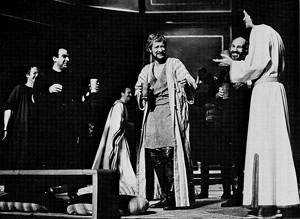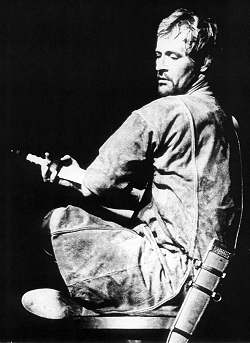|
Twice, scenes shared the stage: IV, x and xi
were played with the two groups of characters side by side on the carpet; IV,
xiii, where Cleopatra plans to escape to her monument and to send Mardian with
false news of her death, was played upstage, behind the screens, while Antony
remained downstage, prostrated in grief, his outstretched arms supported by the
two brass stools. The depth of the stage was elsewhere used with striking
effect for actions half-seen behind the screens. Enobarbus watched Actium far
upstage, back to audience, while the lights faded three times nearly to
blackout and disordered noise and music swelled and faded. At his entry in III,
xi, Antony came forward to speak his first speech within the enclosure, behind
which little light remained: throughout the scene, his followers remained in
this obscure area behind the screens. Most startling of all was the moment,
during Antony's last victorious battle, when blood-soaked sponges were suddenly
thrown at the four screens from behind and slid down, leaving their stains as
part of the setting for the final action.
Visually, the action was chiefly remarkable for
its lucidity: each scene had been allowed to grow into its own shape, and each
scene made its contribution to the unfolding action with such clarity that the
loss of so small a section of text as III, v left a palpable gap in the
narrative by leaving the fate of Pompey and Lepidus undefined. Attention was
focused throughout on the actors: costume too aimed constantly at clarifying
their relationships, functions, even moods. Cleopatra's variety, unusually well
realised by the enormous vocal and emotional range displayed by Glenda Jackson,
was reflected in a chameleon-like succession of robes, encompassing a wider
variety of shape and colour than the rest of the costumes put together and
transforming her by turns into an almost androgynous glamour, a hieroglyphic
formality, a timeless North African grief and abasement and finally a subdued
regal splendour. Apart from Antony's gift of a pearl, hung in a long necklace,
she had no ornaments. Against her, in an opposition more powerfully realised
than in most productions, stood Octavia, a slight, diffident figure,
conspicuous in the only yellow gown on stage, but no icicle or mere political
pawn. Affectionate with her brother , her response to Antony's 'I have not kept
my square' mingled deprecating forgiveness with a hint of frank curiosity. Reds
distinguished Antony's followers, blues, striping a basic white in various
patterns, those of Caesar. Pompey's black was mixed with browns and greys for
his men. Loose robes for the men combined dignity with grace and ease of
movement. Antony's costumes reflected his movements from Egypt to Rome and from
love to war by suggestive alteration rather than total transformation, the
extremes being a striped 'dressing-gown' for act I and light leather armour
with a Tartar helmet for the heroics of IV, iv-xiv.
Within the framework created by the design,
interpretation took the form of a ceaseless search for exact meaning, in every
scene and every speech.. The emphasis was personal; characters were conceived
in terms of the pursuit of personal fulfilment. The production was remarkable
for its generous acceptance of the humanity of every character in the play.
Though increasingly clear-sighted about political realities, even Caesar was
neither cynic nor ambitious plotter. His love of Antony, especially after their
reconciliation, and of Octavia was patently sincere, if as patently immature.
As played by Jonathan Pryce, he was a slightly gawky shy smiler (with no knife
beneath the cloak). Gained authority reduced the gawkiness, but the
naiveté remained in his overt and enthusiastic curiosity on encountering
Cleopatra and in the prolonged backward look at her before his final departure
from the stage at the end of the play.
The heroic fatalism described by Plutarch in
his account of the last days of Antony and Cleopatra may or may not have been
in Brook's mind, but gaiety, even in defeat, was the mood of the production.
Balancing the warmth of Caesar were an Antony and Cleopatra whose delight in
each other was none the less confident and happy for their awareness that it
was also fatal. Resilience was another quality much in evidence. Enobarbus
greeted the news of Fulvia's death with an explosion of incredulous laughter
and Antony, so far worried and shamed ny the news, was surprised into honestly
joining in. After defeat, each new blow, seeming at first to crush all hopes,
only called forth new reserves of courage. Antony in defeat, 'valiant and
dejected' by turns, ranted and swaggered through to a final recovery of
dignity. Cleopatra, glazed into trance-like grief by the death of Antony,
recovered to relish her defeat of Caesar's triumph with light-hearted and
malicious ridicule and to accomodate a transition to and from a mood close to
farce in her scene with Richard Griffiths's red-nosed, hieroglyphic comic-strip
Clown. Joy had a more sombre tinge in Patrick Stewart's grey Enobarbus, a
performance which had gained much in depth and sensitivity since he played the
role in 1972. Risking a powerfully romantic response to the play, and
especially to Cleopatra, Brook drew from the whole of his large cast
performances of the clarity and conviction needed to safeguard such a response
against sentimentalism. He had the good fortune to be able to cast powerful and
experienced actors in many of the play's smallest parts. The search for inner
conviction and for the full meaning of each scene was reflected in the force
and significance of the speaking of lines throughout. Rehearsal activity aimed
at breaking down theatrical cliché and actors' habits is among the most
impressively fruitful of Brook's methods as a director. The text of Antony
and Cleopatra can rarely, if ever, have been so fully and significantly
played. The result was to be observed on (on the second night) in an audience
deeply involved with that experience of renewal of the known play so frequently
recorded by writers on Brook's productions of Shakespeare.
Press response to Antony and Cleopatra,
though appreciative, was also slightly baffled and gave mild hints of
disappointment. Certainly there was no immediate invitation to controversy in
the production. Yet with this production Brook seems to have come closer than
with the Dream, or perhaps even Lear, to an impartial but deeply
committed presentation of the whole play to the senses, intelligence and
imagination of his audience. No axe-grinding cuts, no baseless fabrics of
subtextual subterfuge, no self-indulgent (or didactic) importation of the
activities of the rehearsal-room onto the stage distracted from the play and
its richness of meaning. Nor was the production in any sense untheatrical.
Rarely can the banquet on Pompey's galley have effected so refined a flight
from intoxication into the wilder realms of imagination. Not many directors
have the sheer confidence which can turn the mere pulling of Antony across the
stage looped in the long head-dresses of Cleopatra and her women into a more
powerful image of the difficult hauling of the dying man up into the monument
than any more literal staging could hope to emulate.
In 1978 Peter Brook returned to England with a
production that confirms his great distinction as a director of Shakespeare. In
retrospect, this Antony and Cleopatra may come to seem, as any
production must, to have stressed some aspects of the play at the expense of
others. His rejection of visual elaboration may have endangered the play's
military and imperial themes, but it was a healthy reaction against surviving
mid-Victorian assumptions about staging and costuming Shakespeare. His
projection of the play in no way inhibited the imaginative response of the
audience; and topical concerns of the late 1970s did not distort the production
- rather they informed it and brought conviction to what was, in every sense, a
major revival of the play.
As this account of Antony and Cleopatra
draws on information derived from interviews generously given by the
designer, Sally Jacobs, and by Patrick Stewart, who played Enobarbus, on the
day after the second performance (11 October 1978), and as the interviews
contain much more detail about aspects of the production mentioned above, it
seems proper to conclude with a very slightly abbreviated text of
them.
Interview with
Sally Jacobs
Interview with
Patrick Stewart
|
1. (Harmondsworth: Penguin Books,
1977). |
From: Peter Brook and
Shakespeare, Richard Proudfoot. Printed in Themes In Drama 2:
Drama and Mimesis (C.U.P. 1980). |

